《药理学》课程PPT教学课件(Cardiovascular Sys)27 treatment for CHF2
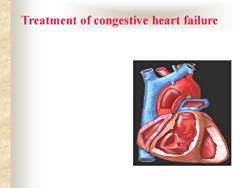
Treatment of congestive heart failure
Treatment of congestive heart failure
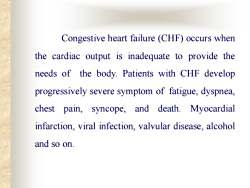
Congestive heart failure (CHF) occurs whenthe cardiac output is inadequate to provide theneeds of the body. Patients with CHF developprogressively severe symptom of fatigue, dyspnea,chest pain, syncope, and death. Myocardialinfarction, viral infection, valvular disease, alcoholand so on
Congestive heart failure (CHF) occurs when the cardiac output is inadequate to provide the needs of the body. Patients with CHF develop progressively severe symptom of fatigue, dyspnea, chest pain, syncope, and death. Myocardial infarction, viral infection, valvular disease, alcohol and so on
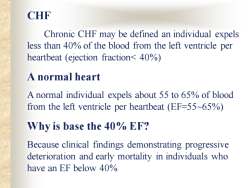
CHFChronic CHF may be defined an individual expelsless than 40%of the blood from the left ventricle perheartbeat (ejection fraction< 40%)AnormalheartAnormal individual expels about 55to65%of bloodfrom the left ventricle per heartbeat (EF=55~65%)Whyisbasethe40%EF?Because clinical findings demonstrating progressivedeterioration and early mortality in individuals whohaveanEFbelow40%
CHF Chronic CHF may be defined an individual expels less than 40% of the blood from the left ventricle per heartbeat (ejection fraction< 40%) A normal heart A normal individual expels about 55 to 65% of blood from the left ventricle per heartbeat (EF=55~65%) Why is base the 40% EF? Because clinical findings demonstrating progressive deterioration and early mortality in individuals who have an EF below 40%
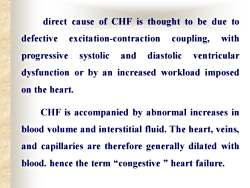
direct cause of CHF isthought to be due towithdefectiveexcitation-contractioncoupling,andsystolicdiastolicventricularprogressivedysfunction or by an increased workload imposedon the heart.CHF is accompanied by abnormal increases inblood volume and interstitial fluid. The heart, veinsand capillaries are therefore generally dilated withblood. hence the term “congestive " heart failure
direct cause of CHF is thought to be due to defective excitation-contraction coupling, with progressive systolic and diastolic ventricular dysfunction or by an increased workload imposed on the heart. CHF is accompanied by abnormal increases in blood volume and interstitial fluid. The heart, veins, and capillaries are therefore generally dilated with blood. hence the term “congestive ” heart failure
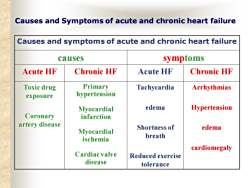
Causes and Symptoms of acute and chronicheart failureCauses and symptoms of acute and chronic heart failuresymptomscausesAcute HFChronic HFAcute HFChronic HFPrimaryToxic drugTachycardiaArrhythmiashypertensionexposureedemaHypertensionMyocardialCoronaryinfarctionarterydiseaseShortnessofedemaMyocardialbreathischemiacardiomegalyCardiacvalveReducedexercisediseasetolerance
Causes and Symptoms of acute and chronic heart failure Causes and symptoms of acute and chronic heart failure causes symptoms Acute HF Chronic HF Acute HF Chronic HF Toxic drug exposure Coronary artery disease Primary hypertension Myocardial infarction Myocardial ischemia Cardiac valve disease Tachycardia edema Shortness of breath Reduced exercise tolerance Arrhythmias Hypertension edema cardiomegaly
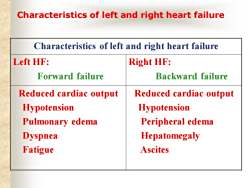
Characteristics of left and right heart failureCharacteristics of left andright heart failureLeft HF:Right HF:Forward failureBackward failureReduced cardiacoutputReduced cardiac outputHypotensionHypotensionPulmonary edemaPeripheral edemaDyspneaHepatomegalyFatigueAscites
Characteristics of left and right heart failure Characteristics of left and right heart failure Left HF: Forward failure Right HF: Backward failure Reduced cardiac output Hypotension Pulmonary edema Dyspnea Fatigue Reduced cardiac output Hypotension Peripheral edema Hepatomegaly Ascites
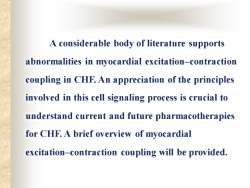
Aconsiderable body of literature supportsabnormalities in myocardial excitation-contractioncoupling in CHF.An appreciation of the principlesinvolved in this cell signaling process is crucial tounderstand current and future pharmacotherapiesfor CHF.A brief overview of myocardialexcitation-contraction coupling will be provided
A considerable body of literature supports abnormalities in myocardial excitation–contraction coupling in CHF. An appreciation of the principles involved in this cell signaling process is crucial to understand current and future pharmacotherapies for CHF. A brief overview of myocardial excitation–contraction coupling will be provided
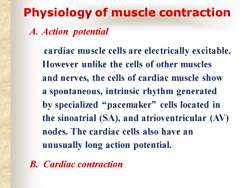
Physiology of muscle contractionA. Action potentialcardiac muscle cells are electrically excitable.However unlike the cells of othermusclesand nerves, the cells of cardiac muscle showa spontaneous, intrinsic rhythm generatedby specialized “pacemaker" cells located inthe sinoatrial (SA),and atrioventricular (AV)nodes.The cardiac cells also have anunusually long action potentialB.Cardiac contraction
Physiology of muscle contraction A. Action potential cardiac muscle cells are electrically excitable. However unlike the cells of other muscles and nerves, the cells of cardiac muscle show a spontaneous, intrinsic rhythm generated by specialized “pacemaker” cells located in the sinoatrial (SA), and atrioventricular (AV) nodes. The cardiac cells also have an unusually long action potential. B. Cardiac contraction
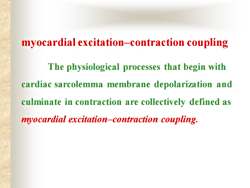
myocardial excitation-contraction couplingThe physiological processes that beginwithcardiac sarcolemma membrane depolarization andculminate in contraction are collectively defined asmyocardial excitation-contraction coupling
myocardial excitation–contraction coupling The physiological processes that begin with cardiac sarcolemma membrane depolarization and culminate in contraction are collectively defined as myocardial excitation–contraction coupling
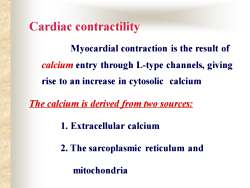
Cardiac contractilityMyocardial contraction is the result ofcalcium entry through L-type channels, givingrise to an increase in cytosolic calciumThe calcium is derived from two sources:1.Extracellular calcium2. The sarcoplasmic reticulum andmitochondria
Cardiac contractility Myocardial contraction is the result of calcium entry through L-type channels, giving rise to an increase in cytosolic calcium The calcium is derived from two sources: 1. Extracellular calcium 2. The sarcoplasmic reticulum and mitochondria
按次数下载不扣除下载券;
注册用户24小时内重复下载只扣除一次;
顺序:VIP每日次数-->可用次数-->下载券;
- 《药理学》课程PPT教学课件(Cardiovascular Sys)28 Agents Used in Hyperlipidemia.ppt
- 《药理学》课程PPT教学课件(Central Nervous Sys)12 central nervous system stimulants.ppt
- 《药理学》课程PPT教学课件(Central Nervous Sys)17 Antiparkin.ppt
- 《药理学》课程PPT教学课件(Central Nervous Sys)13 anesthesia.ppt
- 《药理学》课程PPT教学课件(Central Nervous Sys)18 neuroleptic drugs.ppt
- 《药理学》课程PPT教学课件(Central Nervous Sys)19 opioid analgesics and antagonists.ppt
- 《药理学》课程PPT教学课件(Efferent Sys)05 the autonomic nervous system.ppt
- 《药理学》课程PPT教学课件(Efferent Sys)10 adrenergic agonists.ppt
- 《药理学》课程PPT教学课件(Efferent Sys)06 cholinergic agonists.ppt
- 《药理学》课程PPT教学课件(Efferent Sys)07 adrenergic antagonists.ppt
- 《药理学》课程PPT教学课件(Efferent Sys)12 antidepression.ppt
- 《药理学》课程PPT教学课件(抗菌药物)第三十八章 抗菌药物概论.ppt
- 《药理学》课程PPT教学课件(抗菌药物)第三十九章 β-内酰胺类抗生素.ppt
- 《药理学》课程PPT教学课件(抗菌药物)第四十一章 氨基苷类抗生素.ppt
- 《药理学》课程PPT教学课件(抗菌药物)第四十章 大环内酯类.ppt
- 《药理学》课程PPT教学课件(抗菌药物)第四十三章 人工合成类.ppt
- 《药理学》课程PPT教学课件(血液与内分泌系统药物)第三十四章 肾上腺皮质激素.ppt
- 《药理学》课程PPT教学课件(血液与内分泌系统药物)第三十三章 作用于血液及造血器官药物.ppt
- 《药理学》课程PPT教学课件(血液与内分泌系统药物)第三十六章 甲状腺激素和抗甲状腺药.ppt
- 《药理学》课程PPT教学课件(血液与内分泌系统药物)第三十五章 胰岛素及口服降血糖药.ppt
- 《药理学》课程PPT教学课件(Cardiovascular Sys)29 treatment for angina pectoris.ppt
- 《药理学》课程PPT教学课件(Cardiovascular Sys)20 anti-inflammation drugs.ppt
- 《药理学》课程PPT教学课件(Cardiovascular Sys)23 diuretic.ppt
- 《药理学》课程PPT教学课件(Cardiovascular Sys)25 treatment for arrthymia2.ppt
- 《药理学》课程PPT教学课件(Endocrine Sys)35 insullin.ppt
- 《药理学》课程PPT教学课件(Endocrine Sys)34 adrenocortical hormones.ppt
- 《药理学》课程PPT教学课件(Endocrine Sys)36 thyroid drugs.ppt
- 《药理学》课程PPT教学课件(Antimicrobial Drugs)43b Sulfonamides and other Synthetic Antimicrobial Drugs.ppt
- 《药理学》课程PPT教学课件(Antimicrobial Drugs)43a Quinolones and Urinary Tract Antiseptics.ppt
- 《药理学》课程PPT教学课件(Antimicrobial Drugs)41 Aminoglycosides.ppt
- 《药理学》课程PPT教学课件(Antimicrobial Drugs)42 Tetracyclines, Chloramphenicol.ppt
- 《药理学》课程PPT教学课件(Antimicrobial Drugs)38 Principles of Antimicrobial Therapy.ppt
- 《药理学》课程PPT教学课件(Antimicrobial Drugs)40 Macrolides, Lincomycin, Clindamycin.ppt
- 《药理学》课程PPT教学课件(Antimicrobial Drugs)39 Inhibitors of Cell Wall Synthesis.ppt
- 《生物药剂学与药物动力学》课程教学大纲 Biopharmaceutics and Pharmacokinetics.doc
- 《生物药剂学与药物动力学》课程教学资源(教案,2012版).doc
- 《生物药剂学与药物动力学》课程教学资源(讲稿,2014版).doc
- 《生物药剂学与药物动力学》课程教学资源(试卷习题)试卷6(答案).doc
- 《生物药剂学与药物动力学》课程教学资源(试卷习题)试卷5(答案).doc
- 《生物药剂学与药物动力学》课程教学资源(试卷习题)试卷6(试题).doc
